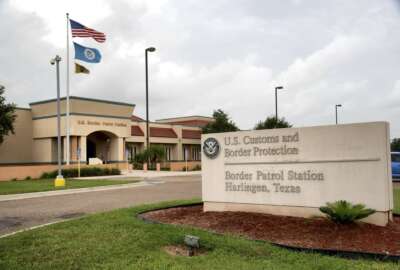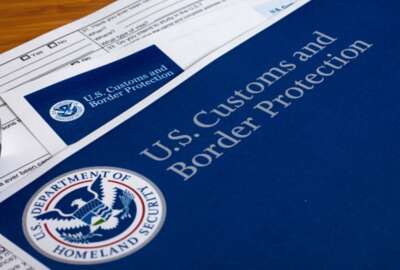Customs and Border Protection tests new global trading system standards
U.S. Customs and Border Protection is fielding new global interoperability standards with the hopes of testing them internationally next year.
International trade requires communications among widely diverse computer systems. A quality called interoperability is required to make trade work smoothly. Now, U.S. Customs and Border Protection is fielding new global interoperability standards with the hopes of testing them internationally next year. For more, the Federal Drive with Tom Temin turns to Vincent Annunziato, the director of CBP’s Business Transformation and Innovation Division.
Interview transcript:
Tom Temin: Now, international trade with some computer-aided communications and bills of lading, transfers and all this kind of thing goes back 50 years or so. What’s new here?
Vincent Annunziato: Well, we started looking at blockchain, believe it or not, in the early days, and we started to find some issues. At the time, it was promised to be the solve world peace, world hunger, all these other things that you might hear about. But we started to see that there were some issues with scaling, costs, speed and then, did we have an exit plan from there would have been very difficult. So we flipped over to global interoperability because basically, this is a standard at the W3C. You build it once. You can communicate with anybody that has the standard and it becomes a communications layer. The big thing from the government side is that it gives either other agencies that are working with us or the private sector the ability to have technology choice.
Tom Temin: Right. Because the nation is trading, not just with Northern European countries that share our values, etc., and many of our technologies, but with virtually every nation on earth.
Vincent Annunziato: Absolutely, and that’s something that we’re very interested in. But there’s even a small portion of this where we use what’s called JSON-LD and it’s multilingual. So you’re able to go in and have key terms defined in every language that’s out there in the native language and there’s no loss at all of understanding or interpretation.
Tom Temin: Because I was going to ask this, share some of the qualities with air traffic control where every country is dealing with every other country, especially the United States and China for that matter. And I think English is the standard language for air traffic control. But in trade, it sounds like you’re a little bit more accommodating to different languages.
Vincent Annunziato: Yeah. I think even at some point, I believe that we could even have what’s called an international single window. And I think we need this type of system to be adopted globally with the standards in order to really make that happen. It’s really an interesting way of building a foundation, a baseline, to move into much more advanced work on the supply chain than we’ve ever done before. I mean, it’s starkly different from what we have now because it’s all linked data.
Tom Temin: And just reading from what the CBP has put out, you have two data standard groups, the U.S. and Global Legal Entity Identifier Foundation, which I guess, is kind of analog to any kind of system where, like the GSA, has to identify entities and Food and Drug Administration. Tell us about those groups, especially the FDA. How do they figure in this?
Vincent Annunziato: When you’re talking about life and GS1, there are data standards that are using ways of identifying corporations. GS1 has, it’s called the credential. They can use that to identify products and you’re able to get money from what we would call a third party attestation. So an outside group attesting to the value of the ID. What’s unique about that is that, because we’re using this new technology, the systems are actually able to verify the legitimacy of what’s being sent to us from the issuer, whoever’s issuing it. So it’s very interesting in that aspect of it.
Tom Temin: That sounds like a good tool to use in anti-counterfeiting activities, which is a big priority for CBP.
Vincent Annunziato: Yeah. A lot of the trade has been asking me because they’re very worried about enforcement based on what happened with 21CCF legislation. And we are really looking at facilitating the legitimate players because what we’re getting is a transparent supply chain. From beginning to end, we’re able to see who’s handling the goods, where it’s geographically located and what exactly that product is so we can make much better decisions based on that data.
Tom Temin: We’re speaking with Vincent Annunziato. He’s director of the Business Transformation and Innovation Division at U.S. Customs and Border Protection. What might be helpful is maybe walk us through a trade scenario of what happens, how the computer systems talk to one another, and therefore how these standards would apply.
Vincent Annunziato: Would it be OK with you Tom if I just gave a little bit of what the issue is?
Tom Temin: Sure.
Vincent Annunziato: And then work into that? So a lot of people are asking why are we modernizing a second time? We just modernized off of a mainframe and we moved on to ACE. Well, we were only able to do that from a technical standard. This is the first time that we’re moving everything from a business perspective, and we’re starting to see the value of helping out making those decisions earlier in the process, giving more assurance to the trade on the fact that their goods can be facilitated. So there’s this great documentary that I was watching not too long ago where an online company was being interviewed and they were talking to this young lady, 16 years old, who by any stretch of the imagination looked like just your average young lady walking out on the street. So as you’re interviewing her, you come to find out she has over a million followers. She’s an internet influencer and she’s really expert in cosmetics. And every time she says, ‘Buy this,’ she’s got this whole audience that’s going out and buying this product. So she says, ‘Buy this lipstick,’ they flip over to this other nondescript young lady who’s following and the next thing you know, she gets this product, she applies it onto her lips and then guess what happens? She gets her lips super glued together. So I always say that it’s not just dirty bombs and terrorism. We also have to look out for the lipstick in the haystack, right? You gotta find these small things. It could be things for a child poised with lead, they got to protect children from all these different missions that are out there. So we really needed to build something that allows us to really look at how do we eventually build the transparent supply chain and make decisions earlier so that eventually, we may even be able to stop the goods from leaving or exporting from foreign shores before they come into our commerce. So what happens in a day in the life of this new system? Well, we use credentials and what’s called decentralized identifiers. Those are the two standards and the IDs. The decentralized identifiers are unique IDs that can be used on just about anything and they have a public-private pairing. So if you’re on Network A with me, and then we move over to Network C, you can still recognize me, but you can’t steal my persona because I have an encrypted key. The credential is a way of moving the data, but if your audience thinks of it as maybe like a badge, so every time you use your ID to get into a door, it recognizes you. It’s that type of scenario and a really good way of describing this is, for instance, a credential gets you back to the source of the person issuing the data, right?, or entity. So if you want to know that I’m legitimately Vinnie Annunziato, and you have the DMV who’s issued my license, and you can check that. But in the Social Security Office and you can check that and the passport office, you can check that, then you have a 99.9% chance of understanding that I’m legit. So it does this across the supply chain and does that all through automation. We don’t have to have a human in the loop checking that. So it’s able to help us focus our work staff into areas that we’re really need to focus more on, and then move legitimate trade faster. And that’s for not only for us, but also for partner government agencies.
Tom Temin: And what is required for international testing? It sounds like that itself could be a pretty big circus.
Vincent Annunziato: We’re trying to do international testing in 2025. The hardest part right now is not the actual test. It’s getting the documents together so that we can legally test with everybody. So we have to get memorandums of understanding together and push all of that. But the actual tests themselves are pretty straightforward. We have to get these security agreements together for, it’s called an ISA, so that we can trade data and all that. That’s the major thing that I’ve been dealing with over the past couple of months, prepping for the 2025 test. But the international testing is great because the more countries that get involved, the more powerful the system becomes and the safer it becomes for consumers in the environment.
Tom Temin: Yeah, my sympathies for having to deal with lots and lots of lawyers, and especially internationally. But in general, do you find that the nations that we trade with are behind this? This is not something where someone’s going to say, ‘No, we want this standard instead of your standard or that kind of thing’?
Vincent Annunziato: It’s a great question. I think right now, it’s still in the beginning stages, but we do have a lot of support coming. So for instance, Singapore and the EU are already moving down these standards. So that’s really good. We’re working with the border five countries. We’re getting really strong support from the UK right now. Then there’s some South American countries that we’re trying to work with as well that are very interested. In fact, we’ve reached out to a company or a bank that funds some of the South American stuff called IDB Bank and we’ve been trying to work with them as well to get a couple of countries on board for testing.
Tom Temin: And do you envision this whole thing being in place, say, some point around 2026?
Vincent Annunziato: It’s not going to happen that you just go poof and everything’s there. What you’ll probably see in the way that we’re doing things right now is that we do a series of tests. We do the initial test with synthetic data, then we put it into operations by using a specialized test that Customs has authority with so that we can assess it in an operational environment. And we’re waiting for legislation 21CCF to be approved, which we think will be happening in the near future. Once that happens, then the pieces that we’ve been putting into production could be opened up for full operations and then expansion for ACE modernization can occur from there as well.
Tom Temin: ACE being the Automated Commercial Environment.
Vincent Annunziato: Yes sir.
Copyright © 2025 Federal News Network. All rights reserved. This website is not intended for users located within the European Economic Area.
Tom Temin is host of the Federal Drive and has been providing insight on federal technology and management issues for more than 30 years.
Follow @tteminWFED





